Land Use and Degradation in a Desert Margin: The Northern Negev
Abstract
:1. Introduction
2. Materials and Methods
2.1. Study Area
2.2. Degradation Mapping
2.3. Mapping Land Uses
2.4. Interpretation of LNS Differences at Local Scales
3. Results
3.1. Differences between Potential and Actual NPP in the Entire Study Area
3.2. Reductions in NPP at Local Scale
3.2.1. Settlements
3.2.2. Bedouin Cultivation
3.2.3. Intensive Cultivation
3.2.4. Pine Plantation
3.2.5. Savannization
3.2.6. Pasture
4. Discussion
5. Conclusions
Author Contributions
Funding
Acknowledgments
Conflicts of Interest
References
- Rosen, S.A. Desertification and pastoralism: A historical review of pastoral nomadism in the Negev region. In Land Use, Land Cover and Soil Sciences; Encyclopedia of Life Support Systems (EOLSS); UNESCO: Oxford, UK, 2009. [Google Scholar]
- Portnov, B.A.; Safriel, U.N. Combating desertification in the Negev: Dryland agriculture vs. dryland urbanization. J. Arid Environ. 2004, 56, 659–680. [Google Scholar] [CrossRef]
- Blaikie, P.; Brookfield, H. Land Degradation and Society; Routledge: London, UK, 1987. [Google Scholar]
- Ben-David, Y. The Negev Bedouin: From nomadism to agriculture. In The Land that Became Israel; Yale University Press: New Haven, CT, USA, 1989; pp. 181–195. [Google Scholar]
- Orenstein, D.; Groner, E.; Lihod, O.; Muithui, W.L.; Krukowski, E.; Arnon, O.; Tal, A. The ecological impacts of homestead settlements in the Negev: Final report. In Proceedings of The Israel Ministry of Environmental Protection; Israel Ministry of Environmental Protection: Jerusalem, Israel, 2009. [Google Scholar]
- Degen, A.A.; Benjamin, R.W.; Hoorweg, J.C. Bedouin households and sheep production in the Negev desert, Israel. Nomadic Peoples 2000, 4, 125–147. [Google Scholar] [CrossRef]
- Kressel, G.M. Let Shepherding Endure: Applied Anthropology and the Preservation of a Cultural Tradition in Israel and the Middle East; State University of New York Press: Albany, NY, USA, 2003. [Google Scholar]
- Meir, A. As Nomadism Ends: The Israeli Bedouin of the Negev; Westview Press: Boulder, CO, USA, 1997. [Google Scholar]
- Kaplan, S.; Blumberg, D.G.; Mamedov, E.; Orlovsky, L. Land-use change and land degradation in Turkmenistan in the post-Soviet era. J. Arid Environ. 2014, 103, 96–106. [Google Scholar] [CrossRef]
- Wolff, P. Savanization-A concept to establish green belts in Israel’s desert areas. Tropenlandwirt 1992, 93, 93–102. [Google Scholar]
- Kaplan, M. National Outline Plan for Forests and Afforestation NOP 22 Policy Document; KKL-JNF: Jerusalem, Israel, 2011; 132p. [Google Scholar]
- Rotem, G.; Bouskila, A.; Rothschild, A. Ecological Effects of Afforestation in the Northern Negev; Environmental Protection Division, Society for the Protection of Nature in Israel: Tel Aviv, Israel, 2014. [Google Scholar]
- Arnon, A.; Svoray, T.; Ungar, E.D. The spatial dimension of pastoral herding: A case study from the northern Negev. Isr. J. Ecol. Evol. 2011, 57, 129–149. [Google Scholar] [CrossRef] [Green Version]
- Prince, S.D. Challenges for remote sensing of the sustainable development goal SDG 15.3.1 productivity indicator. Remote Sens. Environ. 2019, 234, 111428. [Google Scholar] [CrossRef]
- United Nations United Nations Convention to Combat Desertification in Countries Experiencing Serious Drought and/or Desertification, Particularly in Africa; U.N. Doc.; United Nations: New York, NY, USA, 1994.
- Higginbottom, T.; Symeonakis, E. Assessing land degradation and desertification using vegetation index data: Current frameworks and future directions. Remote Sens. 2014, 6, 9552–9575. [Google Scholar] [CrossRef] [Green Version]
- Prince, S.D.; De Colstoun, E.B.; Kravitz, L.L. Evidence from rain-use efficiencies does not indicate extensive Sahelian desertification. Glob. Chang. Biol. 1998, 4, 359–374. [Google Scholar] [CrossRef]
- Wessels, K.J.; Prince, S.D.; Malherbe, J.; Small, J.; Frost, P.E.; VanZyl, D. Can human-induced land degradation be distinguished from the effects of rainfall variability? A case study in South Africa. J. Arid Environ. 2007, 68, 271–297. [Google Scholar] [CrossRef]
- Prince, S.D.; Becker-Reshef, I.; Rishmawi, K. Detection and mapping of long-term land degradation using local net production scaling: Application to Zimbabwe. Remote Sens. Environ. 2009, 113, 1046–1057. [Google Scholar] [CrossRef]
- Prince, S.D.; Jackson, H. Unplanned natural experiments: The case of remote sensing of primary production and its environmental correlations in the Negev. Remote Sens. 2020, 12, 3581. [Google Scholar] [CrossRef]
- Ward, D.; Olsvig-Whittaker, L.; Lawes, M. Vegetation-environment relationships in a Negev desert erosion cirque. J. Veg. Sci. 1993, 4, 83–94. [Google Scholar] [CrossRef]
- Svoray, T.; Karnieli, A. Rainfall, topography and primary production relationships in a semiarid ecosystem. Ecohydrology 2010, 4, 56–66. [Google Scholar] [CrossRef]
- Central Bureau of Statistics. National Geographic Information (NGI) Land-Use Layer; Government of Israel: Jerusalem, Israel, 2009.
- Dan, J.; Yaalon, D.H.; Raz, Z.; Koyumdjisky, H.; Raz, Z. The Soils of Israel (with Map 1:500,000); Pamphlet 159; Agricultural Research Organization, Division of Scientific Publications: Bet Dagan, Israel, 1976.
- Prince, S.D. Spatial and temporal scales of measurement of desertification. In Global Desertification: Do Humans Create Deserts? Stafford-Smith, M., Reynolds, J.F., Eds.; Dahlem University Press: Berlin, Germany, 2002; pp. 23–40. [Google Scholar]
- Avni, Y. Gully incision as a key factor in desertification in an arid environment, the Negev highlands, Israel. Catena 2005, 63, 185–220. [Google Scholar] [CrossRef]
- Sachs, M.; Itshack, M. Savannization: An ecologically viable management approach to desertified regions. In Arid Lands Management. Towards Ecological Sustainability; Hoekstra, T.W., Shachak, M., Eds.; University of Illinois Press: Champaign, IL, USA, 1999; pp. 248–253. [Google Scholar]
- Singer, A. Soils of the Negev; Springer: Berlin/Heidelberg, Germany, 2007; ISBN 978-3-540-71731-7. [Google Scholar]
- Webb, R.H. Recovery of Severely Compacted Soils in the Mojave Desert, California, USA. Arid Land Res. Manag. 2002, 16, 291–305. [Google Scholar] [CrossRef]
- Peters, D.P.C.; Lauenroth, W.K.; Burke, I.C. The role of disturbance in community and ecosystem dynamics. In Ecology of the Short Grass Steppes: A Long-Term Perspective; Lauenroth, W.K., Burke, I.C., Eds.; Oxford University Press: Oxford, UK, 2008; pp. 84–118. [Google Scholar]
- Safriel, U.N.; Berliner, P.; Novoplansky, A.; Laronne, J.B.; Karnieli, A.; Moshe, I.; Kharabsheh, A.; Mohammad, A.G.; Kusek, G. Soil Erosion-Desertification and the Middle Eastern Anthroscapes. In Sustainable Land Management Learning from the Past for the Future; Kapur, S., Eswaran, H., Blum, W.E.H., Eds.; Springer-Verlag: Berlin/Heidelberg, Germany, 2011; ISBN 978-3-642-14781-4. [Google Scholar]
- Rotenberg, E.; Yakir, D. Contribution of semi-arid forests to the climate system. Science 2010, 327, 451–454. [Google Scholar] [CrossRef] [PubMed]
- Grünzweig, J.M.; Gelfand, I.; Fried, Y.; Yakir, D. Biogeochemical factors contributing to enhanced carbon storage following afforestation of a semi-arid shrubland. Biogeosciences 2007, 4, 891–904. [Google Scholar] [CrossRef] [Green Version]
- Schiller, G.; Atzmon, N. Performance of Aleppo pine (Pinus halepensis) provenances grown at the edge of the Negev desert: A review. J. Arid Environ. 2009, 73, 1051–1057. [Google Scholar] [CrossRef]
- Rohatyn, S.; Rotenberg, E.; Ramati, E.; Tatarinov, F.; Tas, E.; Yakir, D. Differential Impacts of Land Use and Precipitation on “Ecosystem Water Yield”. Water Resour. Res. 2018, 54, 5457–5470. [Google Scholar] [CrossRef]
- Derak, M.; Cortina, J. Multi-criteria participative evaluation of Pinus halepensis plantations in a semiarid area of southeast Spain. Ecol. Indic. 2014, 43, 56–68. [Google Scholar] [CrossRef]
- Meir, A.; Tsoar, H. International Borders and Range Ecology: The Case of Bedouin Transborder Grazing. Hum. Ecol. 1996, 24, 39–64. [Google Scholar] [CrossRef]
- Mor-Mussery, A.; Laronne, J.B. The effects of gully erosion on the ecology of arid loessial agro-ecosystems, the northern Negev, Israel. CATENA 2020, 194, 104712. [Google Scholar] [CrossRef]
- Stavi, I.; Perevolotsky, A.; Avni, Y. Effects of gully formation and headcut retreat on primary production in an arid rangeland: Natural desertification in action. J. Arid Environ. 2010, 74, 221–228. [Google Scholar] [CrossRef]
- Montgomery, D.R. Soil erosion and agricultural sustainability. Proc. Natl. Acad. Sci. USA 2007, 104, 13268–13272. [Google Scholar] [CrossRef] [PubMed] [Green Version]
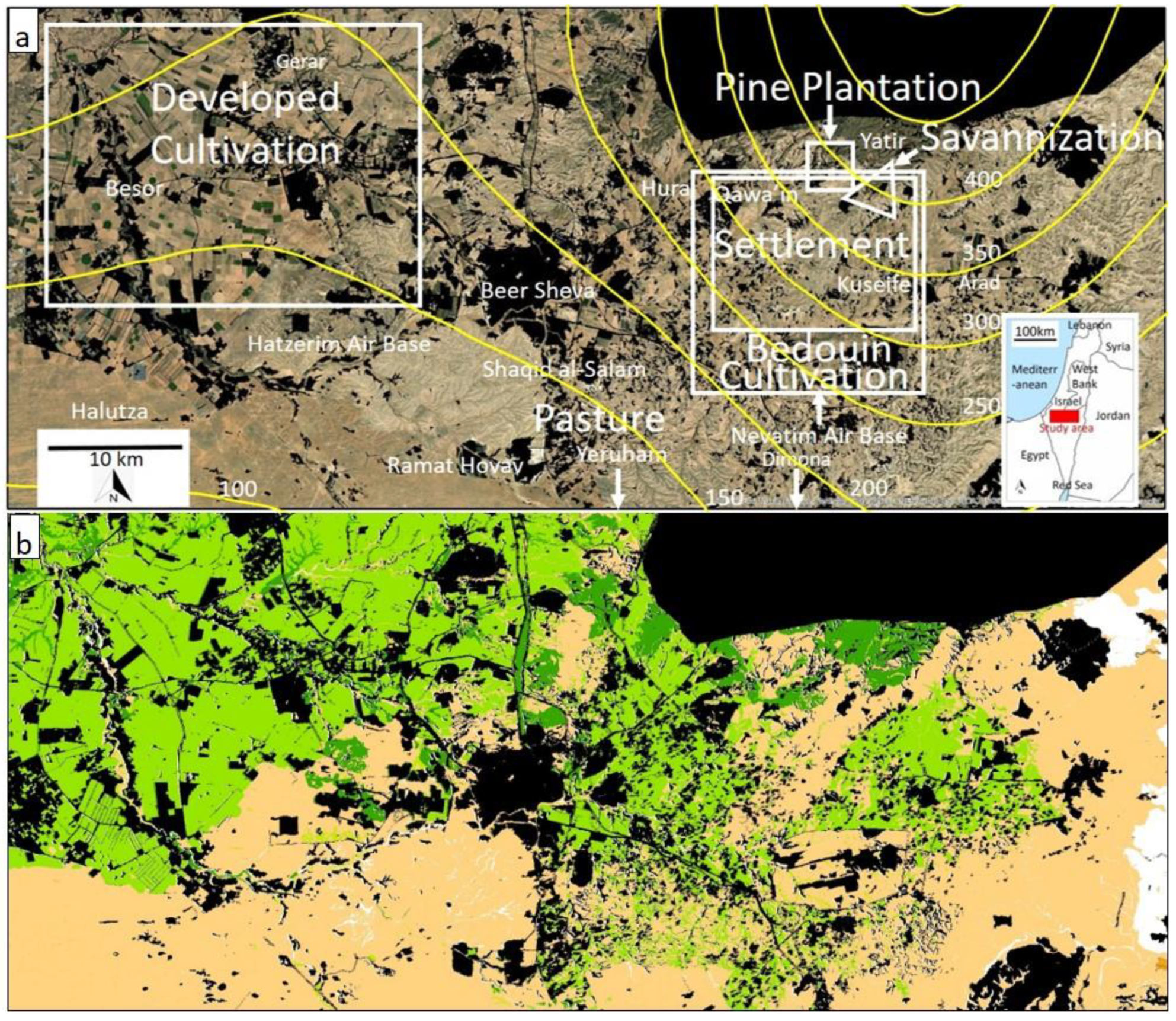
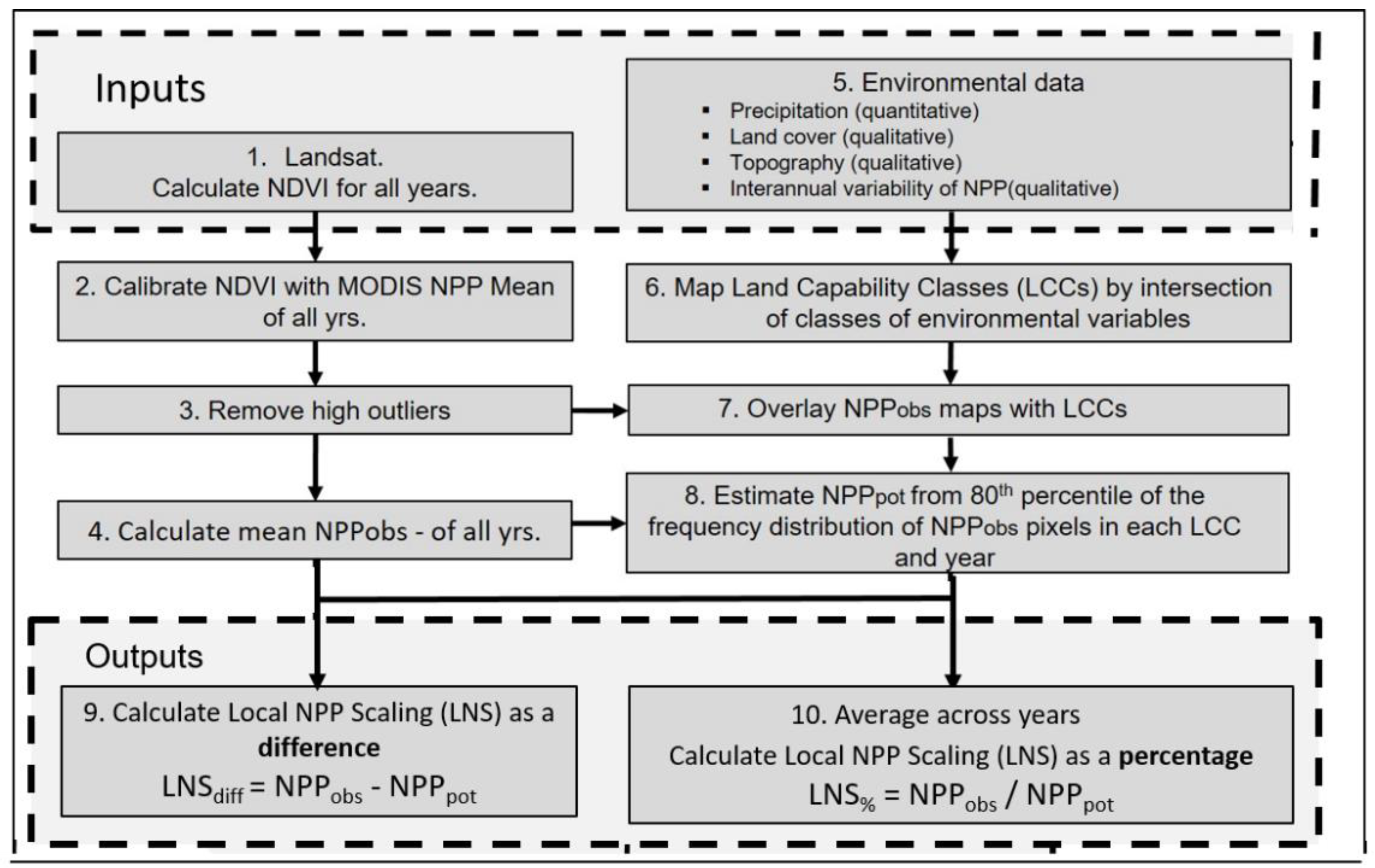

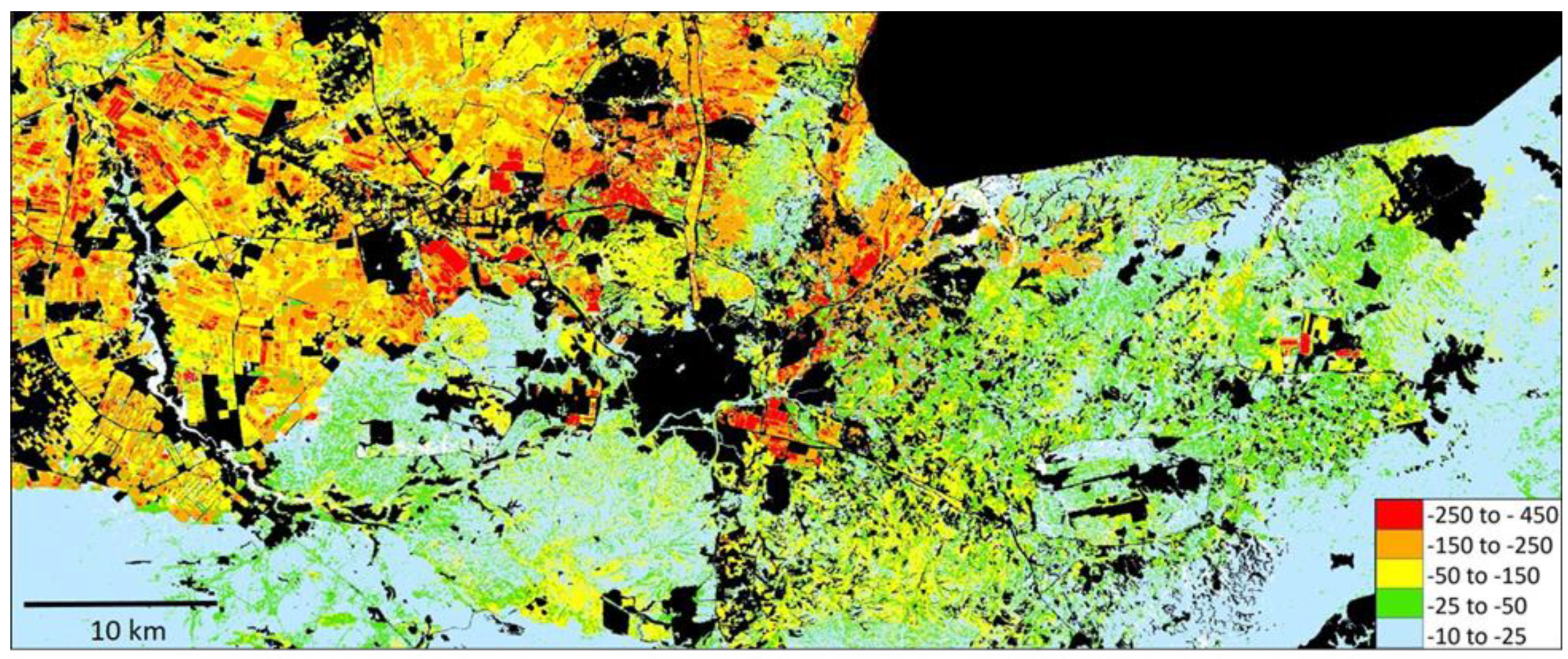
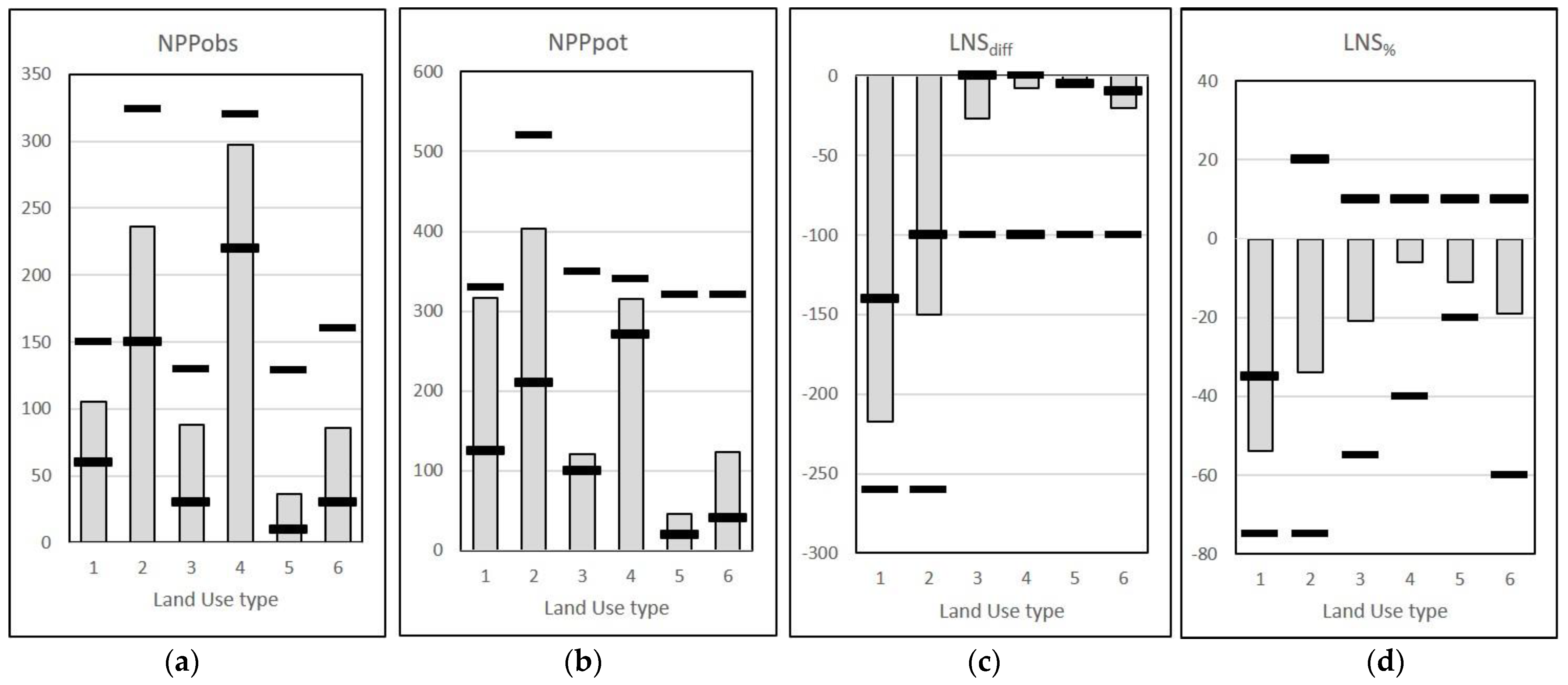
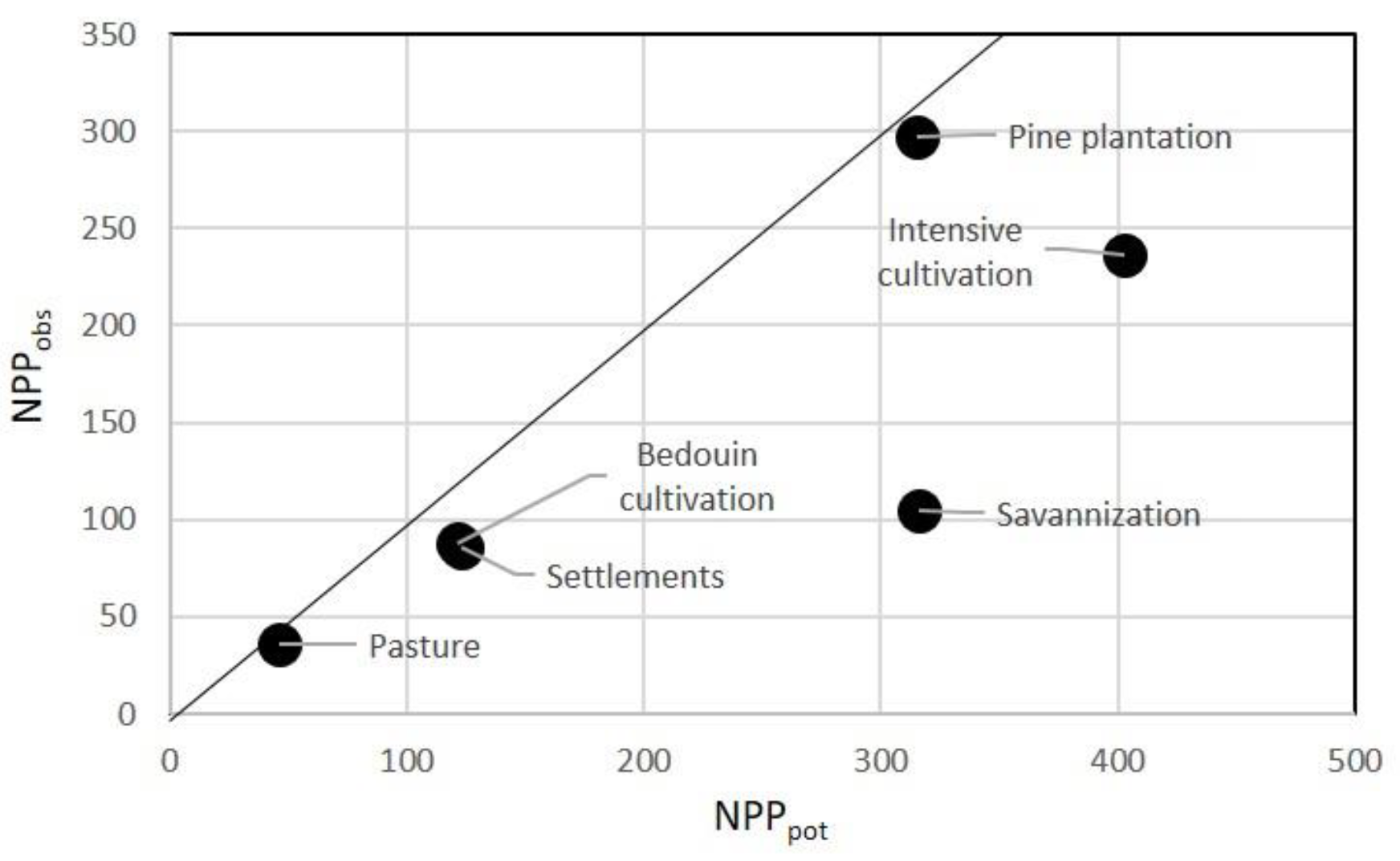
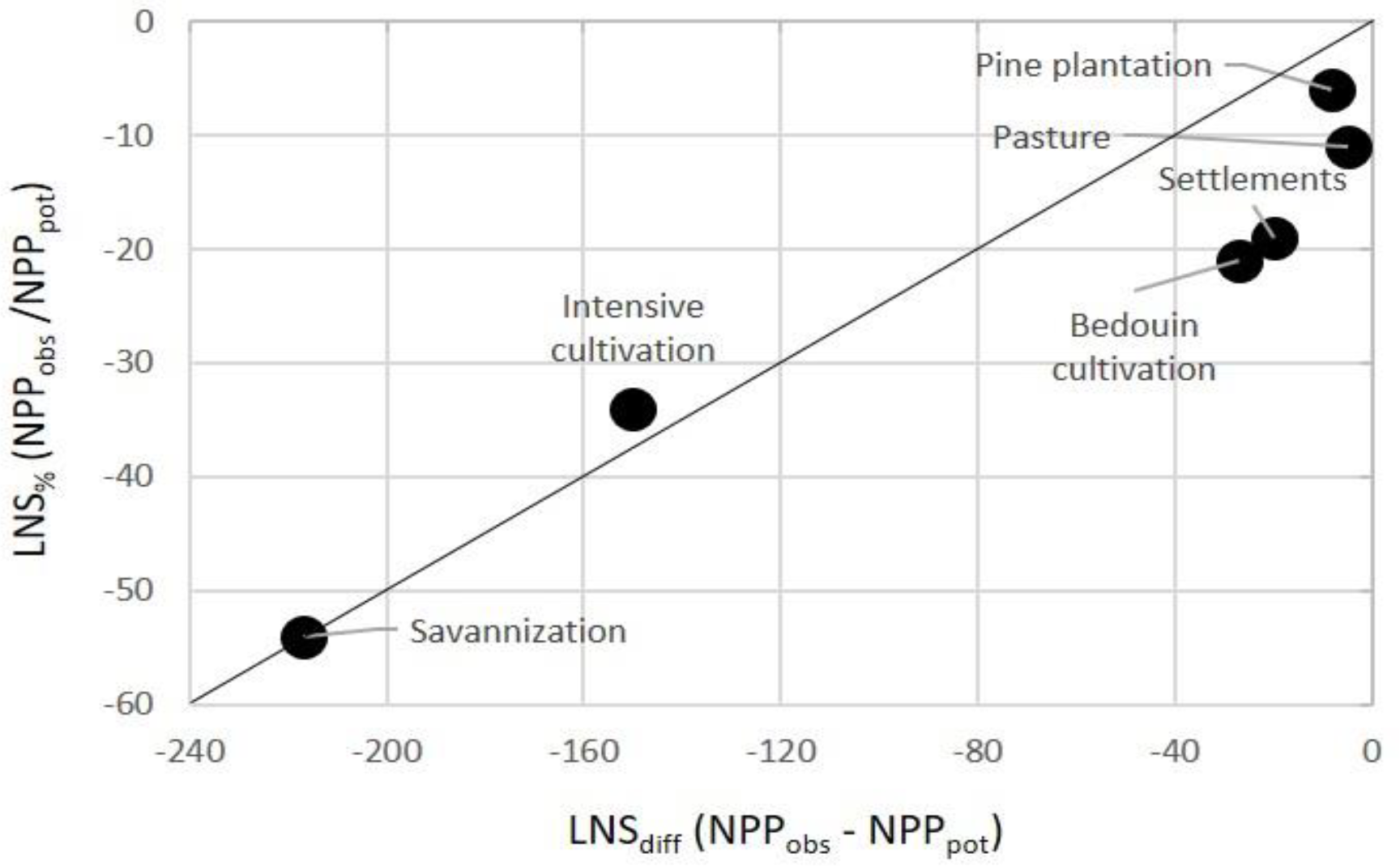


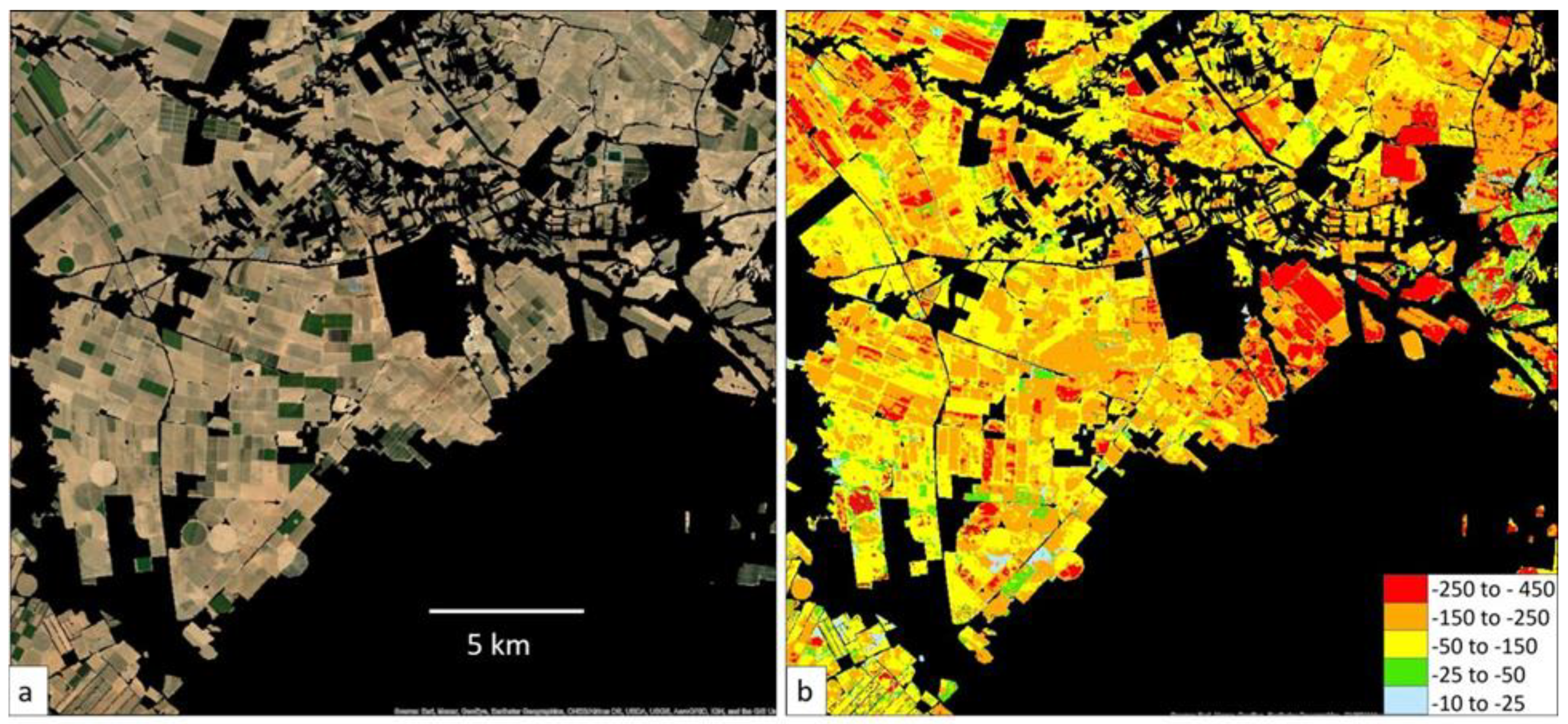


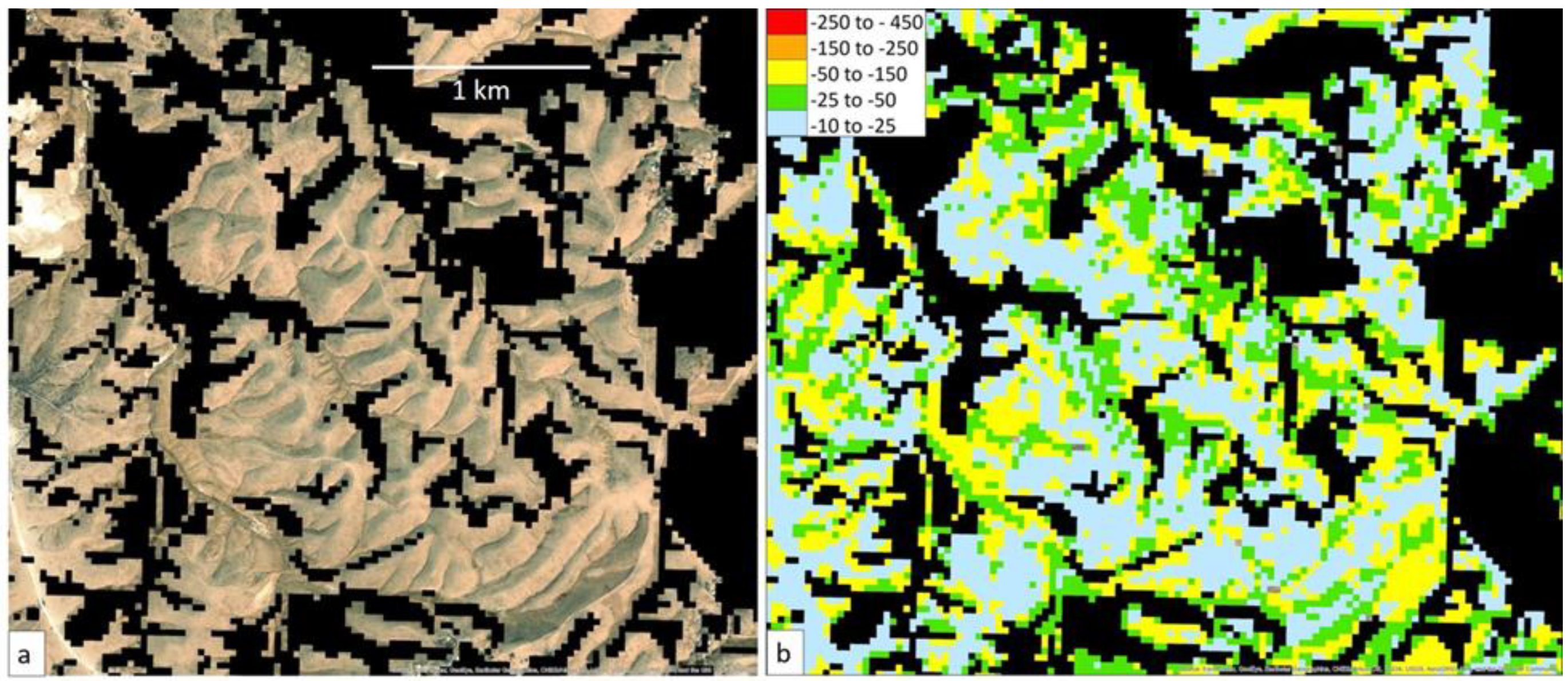
| Land Use (LU) | Descriptions and Locations of Detailed Study Sites |
|---|---|
| Pasture | N and E of Hura on brown lithosols and loessial serozems. Land neither in “agriculture” (NGI class 608) nor “Area with no known characteristic” (NGI Class 600). A rectangle, coordinates: NW corner 31°26.07590′N, 34°48.57397′E; and SE corner 31°7.26285′N, 35°16.89856′E. |
| Bedouin Cultivation | Widespread, but discontinuous E and SE of Beer Sheva, on soils with some loess content. NGI “cultivated land” (Class 608). A rectangle, coordinates: NW corner 31°20.03342′N, 34°55.70703′E; and SE corner 31°9.9272′N, 35°6.93125′E. |
| Savannization | Low hills and slopes N of 200–250 mm isohyet on loess-derived soils. JNF Forest Class #4306. A triangle with coordinates: NW corner 31°18.14239′N, 34°58.96162′E; SE corner 31°19.33678′N, 35°0.98675′E; and E corner 31°17.47428′N, 35°0.56376′E. |
| Pine Plantation | Southern Judean Mountains, mostly N of 350 mm isohyet. Highest altitude and steepest hills of the study region. Mediterranean Brown Forest soils. NGI “Planted Forest” (Class 624). A rectangle, coordinates: NW corner 31°21.52207′N, 35°1.27208′E; and SE corner 31°20.05874′N, 35°3.3906′E. |
| Intensive Cultivation | NW corner of the study area plus small patches N of Beer Sheva. N of 150 mm isohyet, except for some scattered, small, irrigated settlements in the desert. On sandy Regosols, ending at an abrupt southern boundary with the Halutza sands. NGI “Cultivated land” (Class 608). A rectangle, coordinates: NW corner 31°23.08152′N, 34°29.40977′E; and SE corner 31°11.5804′N, 34°20.13461′E. |
| Settlements | A ribbon, 90 to 390 m, surrounding “Area with no known characteristic” (NGI class 600). In a rectangle, coordinates: NW corner 31°19.97237′N, 34°57.06559′E; and SE corner: 31°13.77283′N, 35°7.17938′E. |
| Step | Procedure |
|---|---|
| 1 | NDVI calculated using Landsat 5 bands 3 (630–690 nm) and 4 (750 to 900 nm), Path 174, Row 38. Data were for the years 2001–2010 and 2012. 2011 was omitted owing to poor data. In order to capture as near as possible the peak growing season, and also owing to gaps between suitable acquisitions, the dates of the Landsat were different between years—from day 19 to 141. As the purpose of this study was to make spatial comparisons, these interannual differences were of less consequence, although the patterns of NPP may have changed with seasons, so interannual geographic comparisons may sometimes have been inaccurate. However, they captured most aspects of the spatial variation in the MODIS MOD13Q1 NPP. The spatial resolution of Landsat 30 m (0.1 ha) was appropriate since coarser and finer resolutions make attribution to human activities more difficult. |
| 2 | Growing-season NDVI for each Landsat scene was converted to NPP by regression with NPP from MOD17A3 [18] for the peak of the growing season in each year. MOD17A3 data have a 1 km2 resolution—approximately 11 times coarser than that of Landsat—and, therefore, a finer resolution was obtained by interpolation. Furthermore, MOD17A3 does not cover all the study area, so the calibration had to be made at the northern margins of the Landsat scene. The observed NPP measured using Landsat is referred to as “NPPobs” throughout the text. |
| 3 | High outliers removed from the data for each year. |
| 4 | Average NPP calculated from the 11 annual data sets. |
| 5 | Co-register the environmental data most directly controlling NPP, and for which gridded data exist. |
| 6 | Environmental data used to classify the study area into land capability classes (LCCs) in which they are uniform and distinct from the other LCCs. |
| 7 | Segment the NPPobs data with the map of LCCs. Note that NPPpot is the same for all pixels in an LCC. |
| 8 | Find the 80th percentile (>80th rejected to remove outliers) in the frequency distribution of NPPobs values within each LCC. This is the estimator of the potential NPP (NPPpot), which is the NPP that would occur in the absence of human activity, in a uniform environment [20]. |
| 9 | The divergence between NPPpot and actual observed NPP (NPPobs) calculated as a difference (LNSdiff = NPPobs − NPPpot). |
| 10 | The ratio of NPPobs and NPPpot (NPPobs/NPPpot) expressed as a percentage for each pixel. |
Publisher’s Note: MDPI stays neutral with regard to jurisdictional claims in published maps and institutional affiliations. |
© 2021 by the authors. Licensee MDPI, Basel, Switzerland. This article is an open access article distributed under the terms and conditions of the Creative Commons Attribution (CC BY) license (https://creativecommons.org/licenses/by/4.0/).
Share and Cite
Prince, S.; Safriel, U. Land Use and Degradation in a Desert Margin: The Northern Negev. Remote Sens. 2021, 13, 2884. https://doi.org/10.3390/rs13152884
Prince S, Safriel U. Land Use and Degradation in a Desert Margin: The Northern Negev. Remote Sensing. 2021; 13(15):2884. https://doi.org/10.3390/rs13152884
Chicago/Turabian StylePrince, Stephen, and Uriel Safriel. 2021. "Land Use and Degradation in a Desert Margin: The Northern Negev" Remote Sensing 13, no. 15: 2884. https://doi.org/10.3390/rs13152884
APA StylePrince, S., & Safriel, U. (2021). Land Use and Degradation in a Desert Margin: The Northern Negev. Remote Sensing, 13(15), 2884. https://doi.org/10.3390/rs13152884







